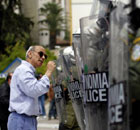Global General
Beethoven knocks on leprosy's door
(China Daily)
Updated: 2010-05-10 08:20
 |
Large Medium Small |
SOROKDO, South Korea - On this small island, long a place of desolation, classical music's most famous first four notes - played by one of its most famous orchestras - pounded into the warm spring day.
"I felt the flow of music was wonderful. My heart seemed to be purified," said one elderly man in this once-isolated leper colony.
He was speaking to a visiting reporter after a performance of Ludwig van Beethoven's Fifth Symphony by Britain's Philharmonia Orchestra last week under the baton of renowned conductor and pianist Vladimir Ashkenazy.
As a reminder of living so long as an outcast on this island in the far south of South Korea, the man, his limbs twisted by leprosy, asked not to be named or filmed.
"You can never be indifferent listening to this symphony. It lifts you up every time ... It is one of the greatest pieces ever composed by one of the greatest composers who ever lived on this miserable earth," said a beaming Ashkenazy, who donated time out of his Asia tour with the orchestra for the concert.
The symphony's startling introduction has been likened, supposedly by the composer himself, to fate knocking on the door. Ashkenazy politely rebuffed attempts to allot a meaning.
"If you say that, fine. But it's still great music. We still feel what it's supposed to mean ... Because music can't be put into words," he said.
He also led the orchestra for two songs by one of South Korea's longest surviving pop stars, Cho Yong-pil.
Established in 1916 in the early years of Japan's colonial rule over the Korean peninsula, the leper colony was chosen for its isolation, not as a hospital.
Most were sent to keep them away from society, not to seek a cure, shunned by their own families, facing forced labor and, for a time, forced sterilization.
Until a bridge was built last year, the only way to the mainland was over water by an intermittent ferry.
All 600 patients, their average age 73, have been cured of what is now called Hansen's disease, but most show the ravages of the illness that has disfigured faces and wrecked limbs, often leaving no more than gnarled stumps in place of hands.
An estimated 14,000 Hansen's patients live in South Korea. Around the world, mostly in its poorer parts, there are an estimated quarter of a million new cases a year of leprosy.
It is caused by the mycobacterium group of germs, which also lead to tuberculosis. Leprosy can relatively easily be treated by drugs before it wreaks havoc on the body.
A large part of the job now, says Park Hyung-cheol who heads the island hospital, is to heal the psychological wounds of his elderly patients who have been ostracized most of their lives.
Reuters






